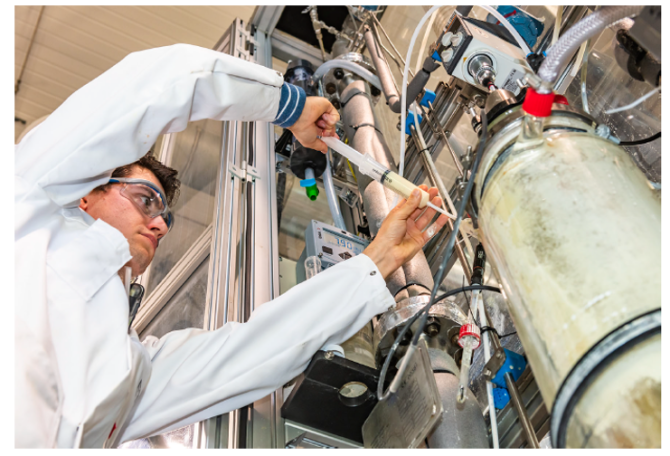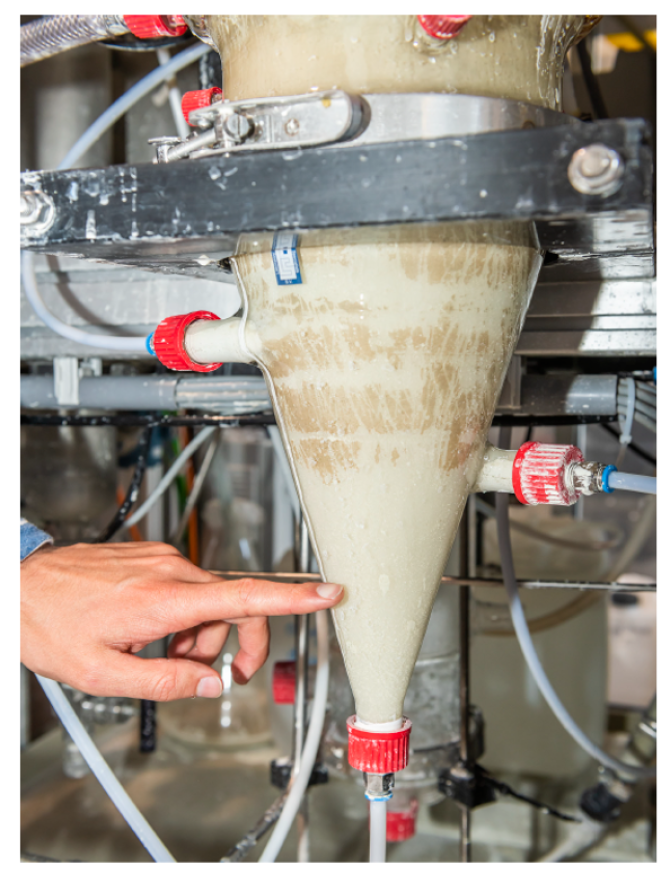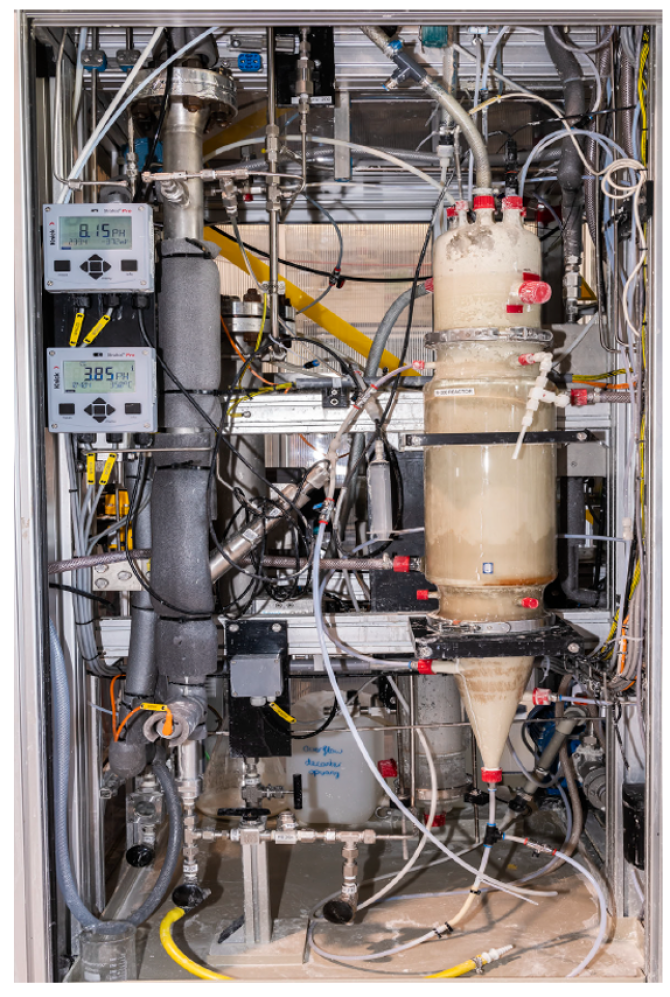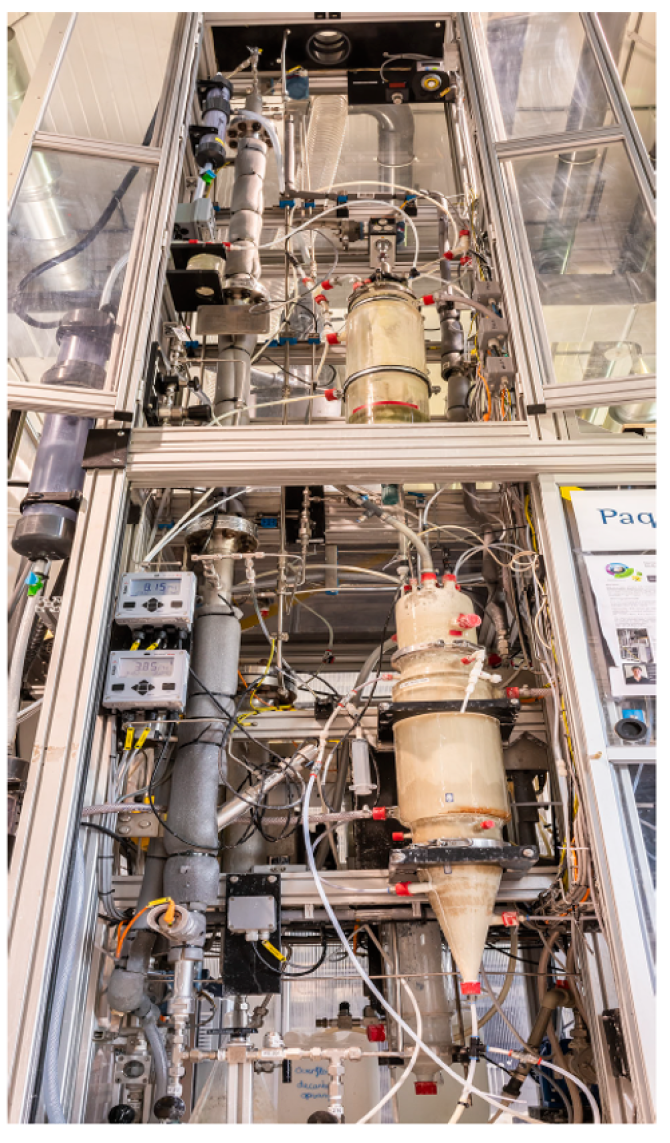
News
Spin-off: Highly efficient sulfurremoval from natural gas
In the early 1990-ies, ETE professor Cees Buisman developed the Thiopaq, an efficient method to remove H2S from gas streams using bacteria. The company Paqell, a joint venture of Paques and Shell, adapted the system to desulfurize natural gas at industrial scale.
Recently, ETE scientist Jan Klok suggested to add a second bioreactor to the traditional system to improve its efficiency. Operation of a pilot-plant to test the process at ETE showed over 99% efficiency. Ph.D. researcher Rieks de Rink further optimizes the process and reactor design.
While balancing on a ladder about 3 meters above the floor, ETE guest scientist Rieks de Rink takes a whitegreyish liquid sample from a four meters high, complex looking device.

Hoses connected to large glass containers, bright stainless steel screws and an impressive looking control panel make up a newly designed bioreactor system for de-sulfurizing natural gas: the Thiopaq O&G Ultra. Inside the pilot reactor, billions of microorganisms convert the toxic hydrogen sulphide (H2S), present in natural gas, into pure sulfur. After the sample has been stored, de Rink adjusts some screws and bolts to fine tune the reactor. ‘We will analyze the amount of dissolved H2S in the sample. This will tell us how much of this chemical is taken up by the bacteria’, de Rink explains. ‘With the information we know if this first step of the desulfurization process is working correctly.’ The second step of the gas purification, the formation of pure sulfur, takes place in a lower placed reaction vessel. Also from this vessel De Rink takes some liquid: ‘Samples from this aerobic bioreactor gives us information about the process efficiency of sulfur formation, the final step in the process.’
Giant leap
H2S is a toxic, corrosive gas present in biogas as well as natural gas. It causes acid rain and smog. Usually, these gas streams are purified using chemical processes. These methods use a number of chemicals, that are harmful for the environment. For example, to purify small amounts of biogas, sodium hydroxide (NaOH) is used. The H2S present dissolves in the alkaline NaOH solution, and is subsequently converted into sodium phosphate. This salt contaminates the environment: it causes eutrophication as well as salinization. In addition, this method is expensive due to use of chemicals. In 1993, ETE Professor Cees Buisman developed a more environmentally friendly biotechnological method to remove H2S from biogas streams produced during wastewater treatment: the Thiopaq. Together with ETE Professor Albert Janssen, the invention was successfully put in the market. It was a giant leap towards sustainable and cost-effective gas desulfurization. Instead of chemicals, bacteria were the main players to remove H2S. De Rink: ‘In one single step, the original Thiopaq converts more than 90 percent of H2S into pure sulphur.

Completely new process
The performance and efficiency of the Thiopaq was impressive. But based on a recent critical evaluation of this revolutionary system, ETE scientist Jan Klok, currently employed at Paqell, hypothesized that the performance could be improved. According to him, the sulfur-forming bacteria had to compete with bacteria of another type: the sulfuric acid (H2SO4)-forming bacteria. This competition, eventually reduced sulphur production, due to H2SO4 formation. In addition, the H2SO4 formed needed to be balanced using NaOH to prevent acidification of the process. To minimize the use of chemicals and improve the sulfur production efficiency of the Thiopaq, these bacteria should be suppressed, so the sulfur-forming bacteria would get an advantage. Based on this theory, the scientists added an extra reactor to the process.

De Rink explains: ‘Based on the suggestions of Klok, the whole process was optimized by adding an extra step to the original Thiopaq design. In this process, the H2SO4-forming bacteria were inhibited in a separate reaction vessel.’ To achieve this, the scientist focused on blocking the bacteria’s enzyme systems, responsible for synthesizing H2SO4, by creating anaerobic conditions and subsequently adding elevated levels of H2S. This compound binds to the enzymes, and effectively blocks their activity, knocking out the H2SO4 synthesis. In a second reaction vessel, with oxygen, the sulfur-forming bacteria now have less competition from the H2SO4-forming bacteria, resulting in a higher conversion of H2S into sulfur and a lower yield of H2SO4. The new process also reduces chemical consumption by about 80-90%, which makes the process more sustainable and attractive for use in the oil and gas industry.
Self-regulative system
The first test results were spectacular. Sulfur production increased from about 90 percent in the original Thiopaq, to over 99 percent in the upgraded Thiopaq O&G Ultra. After filing a patent to protect the new design, de Rink is now optimizing the process even further and aims for a fully self-regulative system: ‘Due to a lot of experience, I am pretty confident in running the system at a high efficiency’, de Rink says. ‘The challenge is to improve the design in such a way that also other operators can maximize the sulfur production.’ To achieve this, de Rink wants to include automatic measurements of hard-core parameters, such as bacterial activity, H2S concentrations, and sulfur production. Based on the results, the future system should respond automatically by adjusting parameters like nutrient concentrations and gas flow. Then, the Thiopaq O&G Ultra will be a fully self-operational gas cleaning system.
